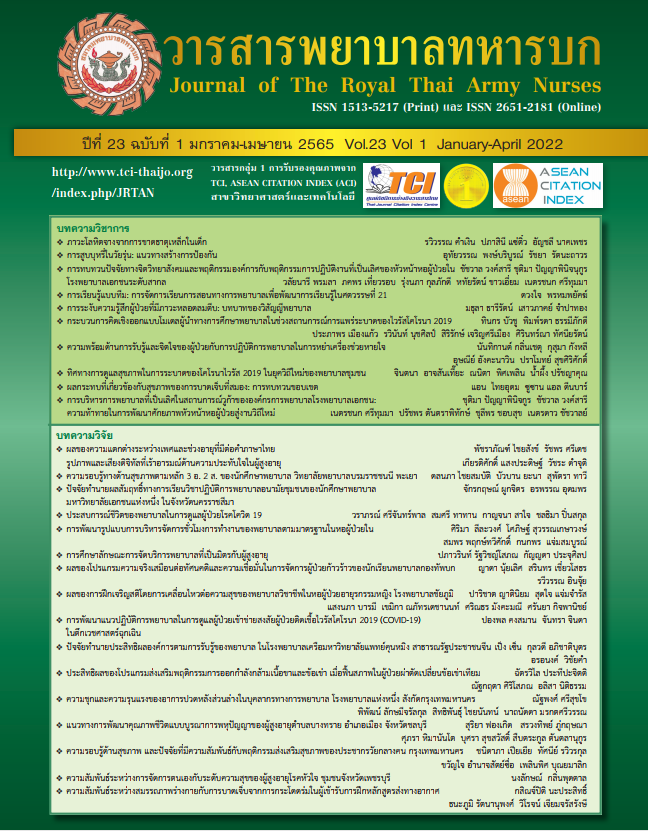Smoking in Adolescents: The Guidelines to Build Preventions
Keywords:
Smoking prevention, Adolescents’ behavior, Self-efficacyAbstract
Smoking is major health problems, there are many operations to reduce the number of smokers. However, the new smokers are still increasing, especially adolescents. The adolescents are age range that if they are addicted to smoking, it will create long-term health problems. The preventions for smoking in adolescents are approaches that change behaviors to become smokers of adolescents. There are important conditions that affect the prevention smoking in adolescents such as; knowledge, behavior in smoking prevention, smoking of close people, and smoking refusal self-efficacy. Therefore, the guidelines to build smoking preventions in adolescents should be integrated these important conditions and social media should be used as an important channel for building adolescents’ smoking prevention activities.
Downloads
References
National Statistical Office, Ministry of Information and Communication Technology. The 2018 Annual Report: National Statistical Office. Bangkok: Thanapress; 2019. (in Thai)
Khamrath J, Meesukmak N. Cigarettes Smoking and Coronary Artery Disease: Nurses’ Role in Smoking Cessation. Journal of The Royal Thai Army Nurses. 2017;18(2):1-6. (in Thai).
World Health Organization. Report on the global tobacco epidemic. Geneva: WHO; 2015.
Wood L, Greenhalgh E M, Vittiglia A, Hanley-Jones S. Factors influencing uptake by young people: overview. Melbourne: Cancer Council Victoria; 2019.
Phetphum C, Nimpitakpong P. A Literature Review of Measures to Limit the Access to Tobacco by Youths. Journal of Public Health. 2015;45(3): 310-323. (in Thai)
Palacheewa N, Thangkratok P. (2019). Digital Technology: Innovation for Smoking Prevention among Children and Adolescents in the Twenty-First Century. Thai Journal of Cardio-Thoracic Nursing. 2019;30(2):15-25. (in Thai)
Vilanti A, Boulay M, Juon H-S. Peer, parent, and media influences on adolescent smoking by development stage. Addict Behav. 2011; 36(1-2):133-136.
Raya P, Benjakul S, Kengganpanich M, Kengganpanich T, Lattanand K. Effects of the smoking cessation program applying transtheoretical model among smokers at Wongwon sub-district, Kuntung district, Trang province. Journal of Boromarajonani College of Nursing, Bangkok. 2015;31(2):9-25. (in Thai)
Srisuriyawet R, Homsin P. Effects of school-based smoking initiation prevention program on tried smoking among early adolescents. Journal of Nursing Science Chulalongkorn University. 2015;27(3):50-67. (in Thai).
Kaewsutha N, Auncheun P, Somsuay P, Weerakul N. The effect of positive tobacco refusal program in dental school program of primary school students, Bangkok. Srinakharinwirot Research and Development (Journal of Humanities and Social Sciences). 2017;9(17):53-68. (in Thai).
Janz, N K, Becker M H. The Health Belief Model: A Decade Later. Health Education Quarterly. 1984;11(1):1-47.
Chainarong I, Pinyopasakul W, Kusuma S, Koositamongkol S. The Relationships among Attitude Toward Exercise, Subjective Norms, Perceived Behavioral Control and Walking Exercise Intention. Journal of The Royal Thai Army Nurses. 2017;18(2):178-185. (in Thai).
Bandura A. Social Foundation of Thought and Action: A Social Cognitive Theory. New Jersy: Prentice-Hall; 1986.
Tiengsomboon U, Treenai S. Predicting Factors of Parents Caring Behavior for Exacerbation Prevention in School-Age Children with Allergic Rhinitis. Journal of The Royal Thai Army Nurses. 2019;20(2):370-379. (in Thai)
Downloads
Published
How to Cite
Issue
Section
License
Copyright (c) 2022 Journal of The Royal Thai Army Nurses

This work is licensed under a Creative Commons Attribution-NonCommercial-NoDerivatives 4.0 International License.
บทความหรือข้อคิดเห็นใดใดที่ปรากฏในวารสารพยาบาลทหารบกเป็นวรรณกรรมของผู้เขียน ซึ่งบรรณาธิการหรือสมาคมพยาบาลทหารบก ไม่จำเป็นต้องเห็นด้วย
บทความที่ได้รับการตีพิมพ์เป็นลิขสิทธิ์ของวารสารพยาบาลทหารบก
The ideas and opinions expressed in the Journal of The Royal Thai Army Nurses are those of the authors and not necessarily those
of the editor or Royal Thai Army Nurses Association.






